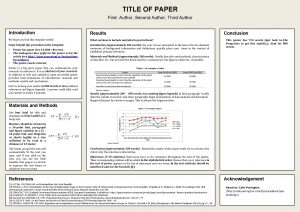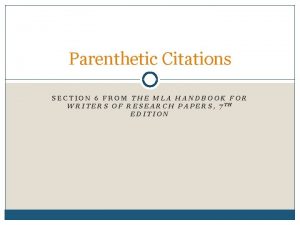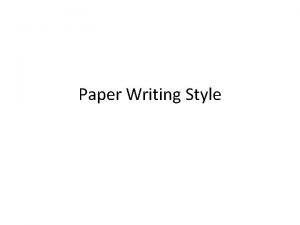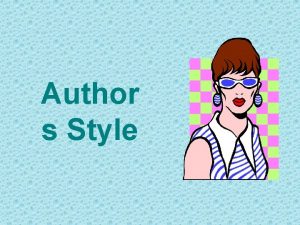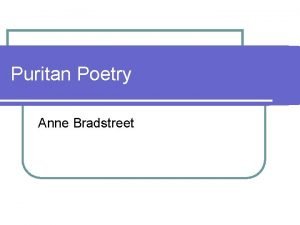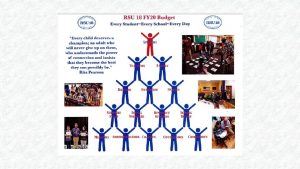Author s Style What is STYLE Every author



















- Slides: 19

Author s Style

What is STYLE ? • Every author has his or her own style – that is, each author uses literary devices, tone, and mood in a particular way that makes his or her writing recognizable. • When you read several books by the same author, you become accustomed to the author’s style of writing and sometimes you look for authors with a similar style.

Author’s Style • Author’s style is the way he or she uses words to make ideas come alive on the page. • Author’s Style Techniques: Word Choice Dialogue Tone Mood Sensory Language

Author’s Style – Word Choice • Author can use formal or informal words • Informal: Jason’s friends dissed him. • Formal: Jason’s friends ignored him.

Author’s Style Formal vs. Informal Formal: Dear Sir, After examining your job description, I feel I am an excellent candidate. I have many years of experience performing these specific duties. My résumé is attached. Please read it over at your convenience and contact me if you have questions. Sincerely, Andrew Meyer Informal: Hey, Sara! What's going on tonight? Call me before you guys leave, okay? --Beth

Author’s Style – Sentence Length • Sentence lengths can vary. • Janice went to the store. She bought a scarf. • Janice went to the department store, where she bought a woolen scarf.

Author’s Style – Dialogue • Shows the reader how characters speak and can show the character’s background. • “I flipped right outta the wagon after he jammed his foot on the brakes. ” • “I am confident the hours he spent sailing the yacht enabled him to pass the exam. ”

Author’s Style – Tone • Tone tells what the author’s attitude toward the subject is. • Formal language creates a serious tone. • Informal language creates a light-hearted tone. • Tarantulas lurk in hidden places in the desert. • Beware of creepy crawlers in the desert. • Setting can help create tone.

Tone Example The girls were playing in the pond, splashing each other and trying to catch fish with their hands. They were having fun, but kept looking over their shoulders at the looming forest. The long grass of the field kept moving and they sort of felt like they were being watched… About a half hour passed and still the girls kept checking the field for movements. It seemed like a pair of dark eyes was on them. They even considered going back inside, but that would mean homework time. So they continued splashing, but with caution now. Their eyes hardly left the field. The tone of this passage is ominous, suggesting a little bit of fear or foreboding. Words like "caution, dark, and looming“ lead readers to the tone.

TONE EXAMPLE Finally, one of the girls pointed to the grass and giggled. "Meow!" A cat sat on the edge of the field and licked its paw. They did indeed have company. The girls ran over to the cat and pet his belly. They laughed and the cat sauntered contently back to the field. The tone of this passage is happy/contentment as there was a successful, happy resolution to the problem. Also, words like giggled and laughed give us clues about the tone.

Author’s Style – Mood • Mood is the atmosphere or feeling that the author creates in the story. • Maria wore a black veil to cover her tears. • The child giggled as she danced around.

MOOD EXAMPLE During the holidays, my mother's house glittered with decorations and hummed with preparations. We ate cookies and drank cider while we helped her wrap bright packages and trim the tree. We felt warm and excited, listening to Christmas carols and even singing along sometimes. We would tease each other about our terrible voices and then sing even louder. Mood: Content, happy. How do we know? Words like "warm, excited, glittered” are used by the author.

MOOD EXAMPLE After New Year's the time came to put all the decorations away and settle in for the long, cold winter. The house seemed to sigh as we boxed up its finery. The tree was dry and brittle, and now waited forlornly by the side of the road to be picked up. Mood: Dreary, depressed. How do we know? "cold, sigh, brittle, forlornly"

Author’s Style – Sensory Language • Sensory Language appeals to the five senses and creates a certain style. • The breeze tossed her golden curls around her head, while the fragrant blossoms entwined in her hair quivered and bounced.

Author’s Style – Sensory Language • Sight words – words that make the reader see what the author sees. i. e. colors, movements, shapes, appearance • Sound words – words that make the reader hear what the author hears. i. e. piercing, rowdy, racket, whisper, mutter, laugh, scream, cry • Taste words – words that make the reader taste what the author tastes. i. e. bitter, tangy, hot, sweet • Smell words – words that make the reader smell what the author smells. i. e. fresh, moldy, putrid, sweet • Touch words – words that make the reader feel what the author feels. i. e. damp, cold, fuzzy, sharp, smooth, sticky

Your turn… We will read a short essay. After we read this essay, you and your group members will analyze the story’s style and provide quotes (textual evidence) as back up for your answers. Answers go on style chart.

Style Analysis Examples TONE: Sedaris’ choice of details reveals his protagonist’s tone of desperation. Textual Evidence: “I started to panic, ” “I was trapped, ” “I scrambled for a plunger” SENSORY DETAILS: Sedaris’ use of sensory details reveals his protagonist’s disbelief at the situation. Textual Evidence: “as thick as a burrito, ” “was the absolute biggest turd I have ever seen in my life”

Class Chart • Let’s share answers and create a style chart.

HOMEWORK • You will read Irving’s “Sleepy Hollow. ” • You will draw out your own–& complete this– Style Analysis chart for the story. • DUE: Beginning of class Wednesday (no time in class will be given)
 First author second author third author
First author second author third author Every knee shall bow every tongue confess
Every knee shall bow every tongue confess Every child every day
Every child every day Every rotarian every year
Every rotarian every year Every nation and every country
Every nation and every country Every nation and every country
Every nation and every country Mission of microsoft
Mission of microsoft Every picture has a story and every story has a moment
Every picture has a story and every story has a moment Citing pages
Citing pages Writing styles examples
Writing styles examples Author’s style
Author’s style Puritan plain style poem examples
Puritan plain style poem examples Referential style vs. expressive style
Referential style vs. expressive style Letter block style
Letter block style Cumulative periodic and inverted sentences
Cumulative periodic and inverted sentences Formal and informal writting
Formal and informal writting Informal vs formal tone
Informal vs formal tone Every system is designed to get the results it gets
Every system is designed to get the results it gets Every second matters
Every second matters Still sweeter every day
Still sweeter every day
